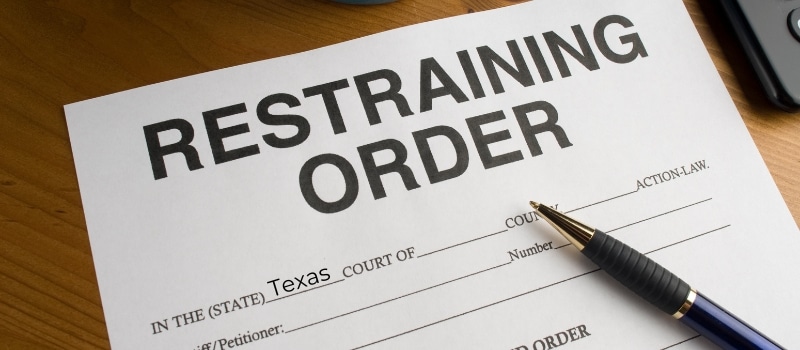Many (if not most) people confuse protective orders with a restraining order in Texas. In the realm of Texas family law, protective orders and restraining orders are used for different purposes, and we will cover the ins and outs of restraining orders here. After reading this article, you may find you really want to know how to file a protective order in Texas vs. how to put a restraining order on someone. If that’s the case, check out these pages as well:
- Removing Protective and Restraining Orders in Texas
- Fort Worth Protective Order Attorneys
- When Do I Need a Domestic Violence Lawyer?
What is a restraining order in Texas?
When people hear the words “restraining order,” they often assume restraining orders are strictly used for vindictive purposes (which is why so many people Google “how do I remove a restraining order” when a more restrictive protective order may be at issue instead). In reality, restraining orders might be better described as “play nice until you get to court” orders.
Temporary Restraining Orders (TROs) are generally filed contemporaneously with a Petition in the majority of Texas family law cases to preserve the status quo and make sure the parties play by the rules during a divorce or custody case.
For example, the courts do not want the parties to remove a bunch of money from a bank account the moment they are served with divorce papers. A TRO signed by a Judge puts standard injunctions in place to ensure that nothing significant changes or happens before a court can hear the evidence and issue an order (or an agreement is reached).
Some counties in Texas, Dallas County for example, automatically include injunctions (that basically act as a TRO) in their standing orders for divorce and child custody cases. Since maintaining the status quo is generally the objective with TROs and standing orders, it’s rare that a party would need to figure out how to beat a restraining order or how to remove a restraining order in Texas.
Restraining orders can enjoin a party from a number of things pertaining to a pending divorce. These may include how the parties are expected to handle marital funds, liabilities and conduct around the children.
As noted above, restraining orders can also prohibit the parties from spending excessive amounts of community funds or incurring unnecessary debt.
Other “play nice” (and common sense) directives found in restraining orders may include ordering the parties to refrain from harassing or disparaging each other, drinking while in possession of the children, hiding or secreting the children and so on. In most cases, restraining orders won’t exclude a party from a couple’s residence until the court decides who gets to stay there.
These so called “kick out orders” require a sworn affidavit and in-person testimony from the party requesting the kick out of their spouse to demonstrate to the Court that safety is an issue.
How to file a restraining order in Texas
Texas Family Code Section 6.501 covers divorce restraining order Texas specifics in fine detail. It explains, “After the filing of a suit for dissolution of a marriage, on the motion of a party or on the court’s own motion, the court may grant a temporary restraining order without notice to the adverse party for the preservation of the property and for the protection of the parties as necessary.” The section also covers the restraining order requirements you can include in the orders.
As noted earlier in this article, some counties have standing orders, which automatically put injunctions in place to preserve the status quo and ensure parties play nice after a party files for divorce. In counties without standing orders, either party to the lawsuit could ask the court to put temporary orders (or a temporary restraining order) in place.
This also applies to suits involving child custody and support, also known as suits affecting the parent child relationship (SAPCRs) in Texas. According to Texas Family Code Section 105.101, “In a suit, the court may make a temporary order, including the modification of a prior temporary order, for the safety and welfare of the child.”
In general, the actual steps you need to take for how to file a restraining order in Texas include:
- File a petition for divorce, petition in suit affecting parent-child relationship or petition to modify in the county where your case will be heard and be sure to include the request for temporary injunctions.
- File a TRO and Order Setting Hearing which tracks the same language as the injunctions requested in your petition. You need to ensure that there is language referencing a date and time of a hearing within 14 days, as a TRO only lasts 14 days by operation of law.
- After the filings are accepted by the county and court, schedule time for the hearing on the orders with the Court Coordinator to be heard within 14 days.
- If you or your children are in imminent danger, and you are requesting extraordinary relief to enjoin a party from being around you or the children, this is referred to as an Ex Parte TRO for Extraordinary Relief. In these cases, if there is an active case with a party or opposing counsel on the other side, you are required to provide a copy of the application to opposing counsel in advance of presenting the application to the court. Advance notice varies from county to county, so be sure to ask your attorney or the County Clerk how far in advance you will need to notify the other party, typically it is two hours notice before presentation.
- Go to court at the appointed time and present your application, which must be attached to a copy of your Petition for Divorce or SAPCR.
- If extraordinary relief is requested, that does not involve a kickout order, the Judge is supposed to just review the four corners of the document and affidavit and not request testimony. However, if the judge asks questions, it is important to answer honestly.
- The judge will then determine whether to sign the TRO and Order Setting Hearing as written, or make changes as he or she sees fit.
- If signed, it is imperative that the party being served and enjoined abides by the judge’s decision.
How much does a restraining order cost?
The cost to file a Texas Restraining Order includes both the cost of the filing of a Petition and the TRO and Order Setting Hearing. In Tarrant County, Texas this typically runs you about $500.00. However, if you hire an attorney to represent you in the family cause of action, this cost is generally included in the original retainer you pay for your attorney’s services.
You may also need to pay court fees to the county, depending on the county where your case will be heard. If you have an attorney, he or she will be able to explain what if any fees you will need to pay in relation to your restraining order. Court fees for restraining orders are typically nominal if a fee is involved.
Can you remove a restraining order in Texas?
Since restraining orders are generally temporary in Texas, it’s very unlikely anyone would ever need to know how to remove a restraining order. A court will issue a TRO that expires by operation of law for 14 days, which is why most Temporary Orders end within the first two weeks of a petition being filed. It may be extended but will not extend past 28 days. The TRO does not last the pendency of the case, but the injunctions can be included in a Temporary Order rendered by the Judge, so fighting a restraining order usually isn’t an issue in Texas.
Restraining order removal just isn’t something you see occurring in family law cases. Instead of removing a restraining order, what generally happens is temporary injunctions are made mutual and included in the Temporary Orders of the Court or they just expire.
In cases where one of the parties is not abiding by the directives of the restraining order or doing something to jeopardize the marital estate, the other party could take steps necessary for enforcing a court order.
For example, if a couple owns a business together, the couple’s temporary restraining orders should include directives for the continued operation of the business. If one party tries to take advantage of the situation for their personal benefit (or out of spite for the other party), the court could include injunctions in the temporary orders that are entered following the TRO. These injunctions could include directives that tighten up that party’s ability to write checks, sell assets, incur debt, use credit cards and so on.
If in fact you actually need to know how to remove a protective order in Texas, visit the aforementioned page listed at the top of this article.
Have more questions about how to file a restraining order?
If you live in the Dallas / Fort Worth area, the experienced family law attorneys at the Sisemore Law Firm are here to help. To schedule a confidential consultation with our firm, you can call our law office at (817) 336-4444 or connect with us online.





